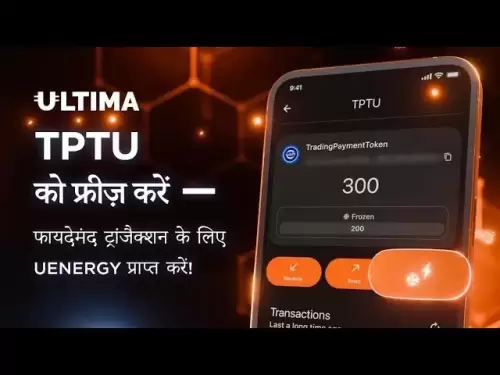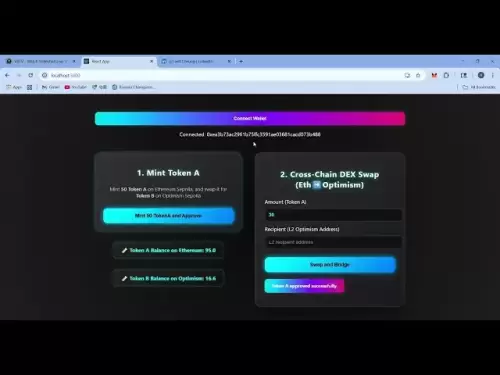-
 Bitcoin
Bitcoin $109,459.7682
2.44% -
 Ethereum
Ethereum $2,598.6052
6.29% -
 Tether USDt
Tether USDt $1.0003
0.00% -
 XRP
XRP $2.2734
3.95% -
 BNB
BNB $661.4886
1.58% -
 Solana
Solana $155.4825
4.35% -
 USDC
USDC $0.9999
-0.02% -
 TRON
TRON $0.2838
1.04% -
 Dogecoin
Dogecoin $0.1740
8.25% -
 Cardano
Cardano $0.6047
9.04% -
 Hyperliquid
Hyperliquid $40.2302
6.50% -
 Sui
Sui $2.9863
10.05% -
 Bitcoin Cash
Bitcoin Cash $509.5786
0.60% -
 Chainlink
Chainlink $13.8156
6.03% -
 UNUS SED LEO
UNUS SED LEO $9.0142
0.69% -
 Avalanche
Avalanche $19.0337
8.68% -
 Stellar
Stellar $0.2438
5.17% -
 Toncoin
Toncoin $2.9012
3.59% -
 Shiba Inu
Shiba Inu $0.0...01210
6.20% -
 Litecoin
Litecoin $90.0882
7.05% -
 Hedera
Hedera $0.1597
8.53% -
 Monero
Monero $326.3340
2.88% -
 Polkadot
Polkadot $3.6365
9.32% -
 Bitget Token
Bitget Token $4.6162
2.72% -
 Dai
Dai $1.0001
0.00% -
 Ethena USDe
Ethena USDe $1.0002
-0.01% -
 Uniswap
Uniswap $7.6403
10.47% -
 Pepe
Pepe $0.0...01060
12.03% -
 Aave
Aave $281.3664
7.56% -
 Pi
Pi $0.4992
1.76%
How to play OKX leverage
To engage in OKX leverage trading, begin by creating an account, funding it with cryptocurrency, selecting a leverage account with desired parameters, executing trades while considering risk management strategies, and understanding the various leverage account types and associated risks.
Nov 19, 2024 at 09:56 pm

How to Play OKX Leverage
Leverage trading is a type of trading strategy that allows traders to increase their potential profits by borrowing capital from a broker. This can be a useful strategy for experienced traders who are looking to increase their returns, but it is important to remember that leverage trading also comes with increased risk.
If you are new to leverage trading, it is important to start by learning the basics. This includes understanding how leverage works, the different types of leverage accounts, and the risks involved. Once you have a good understanding of the basics, you can start to explore different leverage trading strategies.
Here are the steps on how to play OKX leverage:
- Open an OKX account.
The first step is to open an OKX account. You can do this by visiting the OKX website and clicking on the "Sign Up" button. Once you have created an account, you will need to verify your identity by providing a government-issued ID.
- Fund your account.
Once your account is verified, you will need to fund it with a cryptocurrency. You can do this by depositing a cryptocurrency from another wallet or by purchasing cryptocurrency with a credit card or debit card.
- Choose a leverage account.
OKX offers two types of leverage accounts: standard accounts and margin accounts. Standard accounts have a leverage ratio of 1:1, which means that you cannot borrow any capital from the broker. Margin accounts have a higher leverage ratio, which means that you can borrow capital from the broker in order to increase your potential profits.
- Place an order.
Once you have chosen a leverage account, you can start placing orders. When you place an order, you will need to specify the amount of leverage that you want to use. You can use leverage to increase your potential profits, but it is important to remember that leverage also comes with increased risk.
- Manage your risk.
Leverage trading can be a profitable strategy, but it is also important to manage your risk. This means setting stop-loss orders and taking profits when your trades are profitable. It is also important to be aware of the risks involved in leverage trading and to trade with a plan.
The Different Types of Leverage Accounts on OKX
As mentioned above, OKX offers two types of leverage accounts: standard accounts and margin accounts. Standard accounts have a leverage ratio of 1:1, which means that you cannot borrow any capital from the broker. Margin accounts have a higher leverage ratio, which means that you can borrow capital from the broker in order to increase your potential profits.
The following is a table that compares the two types of leverage accounts on OKX:
| Feature | Standard Account | Margin Account |
|---|---|---|
| Leverage ratio | 1:1 | Up to 100:1 |
| Borrowing costs | None | Interest charged on borrowed capital |
| Minimum deposit | None | Varies |
The Risks of Leverage Trading
Leverage trading can be a profitable strategy, but it is also important to be aware of the risks involved. The following are some of the risks of leverage trading:**
- Increased volatility: Leverage trading can increase the volatility of your trades, which means that your profits and losses can be amplified.
- Margin calls: If the value of your trades falls below a certain level, you may receive a margin call from your broker. This means that you will need to deposit additional funds into your account or close out your trades.
- Liquidation: If you fail to meet a margin call, your broker may liquidate your trades. This means that you will lose all of your invested capital.
Conclusion
Leverage trading can be a powerful tool for experienced traders who are looking to increase their returns, but it is important to remember that it also comes with increased risk. If you are new to leverage trading, it is important to start by learning the basics and to trade with a plan.
Disclaimer:info@kdj.com
The information provided is not trading advice. kdj.com does not assume any responsibility for any investments made based on the information provided in this article. Cryptocurrencies are highly volatile and it is highly recommended that you invest with caution after thorough research!
If you believe that the content used on this website infringes your copyright, please contact us immediately (info@kdj.com) and we will delete it promptly.
- Eurau Stablecoin: Deutsche Bank, Galaxy, and Bafin Approval Usher in New Era
- 2025-07-03 20:30:12
- Solana DEX Volume and Ranking: Riding the Wave to the Top
- 2025-07-03 21:10:20
- BONK ETF Buzz: News, Catalysts, and What's Driving the Meme Coin Mania
- 2025-07-03 21:10:20
- Check Your Change! That 1p Coin Could Be Worth £200k!
- 2025-07-03 21:20:17
- Mosman Oil's Vecta Termination: A Drilling Programme Debrief
- 2025-07-03 20:30:12
- HYPE Price Forecast: Will It Reach $50 by July 2025?
- 2025-07-03 21:20:18
Related knowledge

How to identify the contract value range in combination with the market profile?
Jul 02,2025 at 10:56pm
Understanding the Market ProfileTo effectively identify the contract value range in combination with the market profile, it's essential to first understand what each concept entails. The market profile is a framework that helps traders visualize how price and time interact across a given period, typically a trading day or session. It provides insights i...

How to use the price slope to filter the false breakthrough signal of the contract?
Jun 20,2025 at 06:56pm
Understanding the Concept of Price Slope in Contract TradingIn contract trading, especially within cryptocurrency derivatives markets, price slope refers to the rate at which the price changes over a specific time period. It helps traders assess the strength and sustainability of a trend. A steep slope may indicate strong momentum, while a shallow slope...

How to determine the expected volatility of the contract through the volatility cone?
Jun 19,2025 at 12:28pm
Understanding the Basics of Volatility in Cryptocurrency ContractsIn the realm of cryptocurrency trading, volatility is a key metric that traders use to assess potential risk and reward. When dealing with futures contracts, understanding how volatile an asset might become over time is crucial for position sizing, risk management, and strategy developmen...

How to formulate a contract intraday trading plan in combination with the pivot point system?
Jun 21,2025 at 03:42pm
Understanding the Basics of Pivot Points in Cryptocurrency TradingPivot points are technical analysis tools used by traders to identify potential support and resistance levels. These levels are calculated using the previous day's high, low, and closing prices. In the context of cryptocurrency trading, where markets operate 24/7, pivot points help trader...

How to adjust the contract position ratio through the price fluctuation entropy?
Jun 22,2025 at 11:42am
Understanding Price Fluctuation Entropy in Cryptocurrency ContractsIn the world of cryptocurrency futures trading, price fluctuation entropy is a relatively new concept used to measure market volatility and uncertainty. It derives from information theory, where entropy refers to the degree of randomness or unpredictability in a system. In crypto contrac...

How to use the volume swing indicator to predict the contract volume-price divergence?
Jun 18,2025 at 11:42pm
Understanding the Volume Swing IndicatorThe volume swing indicator is a technical analysis tool used primarily in cryptocurrency trading to evaluate changes in volume over time. Unlike price-based indicators, this metric focuses solely on trading volume, which can provide early signals about potential market reversals or continuations. The key idea behi...

How to identify the contract value range in combination with the market profile?
Jul 02,2025 at 10:56pm
Understanding the Market ProfileTo effectively identify the contract value range in combination with the market profile, it's essential to first understand what each concept entails. The market profile is a framework that helps traders visualize how price and time interact across a given period, typically a trading day or session. It provides insights i...

How to use the price slope to filter the false breakthrough signal of the contract?
Jun 20,2025 at 06:56pm
Understanding the Concept of Price Slope in Contract TradingIn contract trading, especially within cryptocurrency derivatives markets, price slope refers to the rate at which the price changes over a specific time period. It helps traders assess the strength and sustainability of a trend. A steep slope may indicate strong momentum, while a shallow slope...

How to determine the expected volatility of the contract through the volatility cone?
Jun 19,2025 at 12:28pm
Understanding the Basics of Volatility in Cryptocurrency ContractsIn the realm of cryptocurrency trading, volatility is a key metric that traders use to assess potential risk and reward. When dealing with futures contracts, understanding how volatile an asset might become over time is crucial for position sizing, risk management, and strategy developmen...

How to formulate a contract intraday trading plan in combination with the pivot point system?
Jun 21,2025 at 03:42pm
Understanding the Basics of Pivot Points in Cryptocurrency TradingPivot points are technical analysis tools used by traders to identify potential support and resistance levels. These levels are calculated using the previous day's high, low, and closing prices. In the context of cryptocurrency trading, where markets operate 24/7, pivot points help trader...

How to adjust the contract position ratio through the price fluctuation entropy?
Jun 22,2025 at 11:42am
Understanding Price Fluctuation Entropy in Cryptocurrency ContractsIn the world of cryptocurrency futures trading, price fluctuation entropy is a relatively new concept used to measure market volatility and uncertainty. It derives from information theory, where entropy refers to the degree of randomness or unpredictability in a system. In crypto contrac...

How to use the volume swing indicator to predict the contract volume-price divergence?
Jun 18,2025 at 11:42pm
Understanding the Volume Swing IndicatorThe volume swing indicator is a technical analysis tool used primarily in cryptocurrency trading to evaluate changes in volume over time. Unlike price-based indicators, this metric focuses solely on trading volume, which can provide early signals about potential market reversals or continuations. The key idea behi...
See all articles

























































































